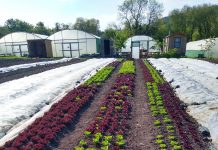September is the real beginning of summer handing over to autumn, and although it is still a time of harvest, the cooler temperatures, shorter days and damper soils bring a different feel to work in the garden. It is a sort of second spring with new plantings and sowings in August (such as salads, turnips, winter radish, fennel, chicory, chard, pak choi, Chinese cabbage, kohl rabi and kale) putting on lots of lush growth.
It is a good idea to try and keep as much of the soil covered as possible over winter and September is the right time to start thinking about this (I know it feels too soon to be thinking about winter…). There is still time to sow green manures if you have areas that are bare after harvesting summer crops. Ideally sowing a good mix of green manures will ensure different root depths and provide the diversity of roots in the soil that will lead to higher levels of microbial activity and in turn more organic matter and better drainage and nutrient retention. We usually sow phacelia, cereal rye, vetch and sometimes oats and mustard or fodder radish. Phacelia is not hardy unless it is sown in September, in which case it grows only a few centimetres tall and is not damaged by the frosts, but instead covers the ground and helps to reduce compaction from winter rains and maintain a healthy soil. We then mow these green manures down in the spring a few weeks before we need to plant in them, we cover with black plastic after mowing and this kills off the green manure and any other weeds.
Another technique to make sure that there is crop cover overwinter is to undersow vegetable crops with green manures which will slowly grow through the summer and then get going in the autumn once the crop is taken out. We undersow our squash plants with red and white clover along with yellow trefoil and maybe a few wildflowers soon after planting the squash (once they have about 5 true leaves). Ideally hoe the ground two or three times before broadcasting the green manure seed, this will knock back the weed burden and create a tilth for the green manure seed to germinate. If conditions are dry then water the seed in. Once the squash are harvested in autumn we flail mow the beds, rake off the debris and then oversow with rye and vetch. This germinates in fairly low temperatures and puts some growth on before winter giving a good ground cover.
If crops are still in the ground until November time then beds can be mulched with compost or even straw overwinter (as it will be too late to sow most green manures) to lessen the impact of the rain on the soil and to feed soil life through the winter. The only thing to watch out for when covering the soil overwinter like this is slugs, so be prepared to squish a few in the spring once the plastic has been taken off or straw has been raked off.
Anyway, enough of this winter talk—let’s hope that September provides us with the Indian summer that we are always after!
WHAT TO SOW THIS MONTH: Direct sown outside: turnip greens, leaf radish, red Russian kale as salad leaf. Sow in trays: overwintering salad leaves for cloches or polytunnel/glasshouse such as winter purslane, landcress, rocket, mustards, corn salad, endive, chervil, lettuce. Also spring onions for overwintering in a cloche or tunnel/glasshouse
WHAT TO PLANT THIS MONTH:
OUTSIDE: salad leaves: leaf radish, winter purslane, landcress, rocket, mustards, overwintering spring onions, spinach and spring cabbage.
INSIDE: overwintering salad leaves (at the end of the month and into October), chard, coriander, chervil and parsley.
OTHER IMPORTANT TASKS THIS MONTH: Get your squash in by the end of the month and cure them either in a glasshouse, polytunnel or ideally in your house—this will make sure that the skins are hard and will last through the winter.








